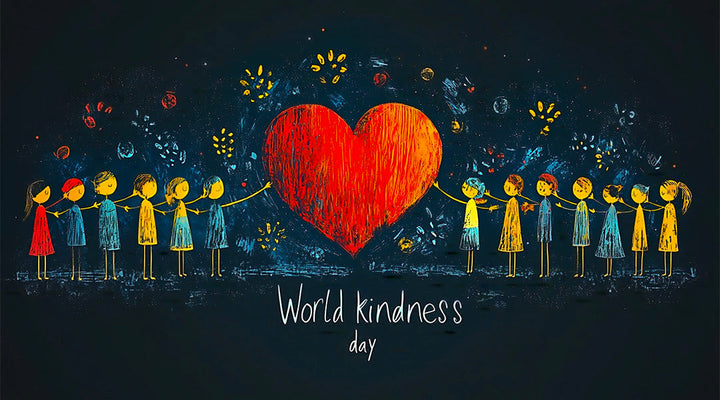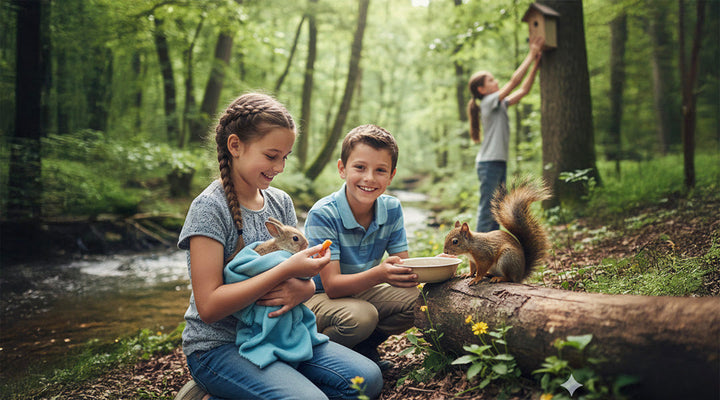
Spreading Kindness, Care, And Cheer Through Caroling This Holiday Season
“The best way to spread Christmas cheer is singing loud for all to hear.” - Buddy the Elf
This line from the movie Elf has become a familiar one over the last several years, but is it just a catchy phrase from a popular movie, or can singing truly spread cheer to others?
I remember, as a child, going to nursing homes, assisted living facilities, and many elderly homes with the youth from our church where we’d sing carols in hopes of bringing joy and lifting spirits amidst the holiday season.
And honestly, what still comes to my mind when I recall those outings is the number of smiles seen and the overwhelming feeling of joy sensed from those hearing the carols.
Sometimes tears would well up in the eyes of the hearers as they’d later express that such songs brought to their mind fond memories of holidays’ past. But, each and every person that received this gift of caroling (yes, I’m referring to this practice as a gift) ultimately shared with us how grateful they were for the joy and cheer we brought to them through this act.
Admittedly, caroling doesn’t seem to be as popular a practice today as it was then, but I think we can all agree that anything which spreads kindness, joy, and cheer is something our world could always use more of, throughout the holiday season and beyond.
So, today we’d like to highlight this practice, exploring its origins as well as all the ways this wonderful tradition can bring joy and happiness both to the hearers and those caroling.
The History Of Caroling

Most records indicate that the tradition of singing Christmas carols dates back to the 14th century.
During this time, the first carols were thought to be produced by followers of Saint Francis of Assisi, but this first occurrence of caroling looked much different than what we’re familiar with today.
Franciscan friars prompted this early practice of caroling which then involved dancing in a circle, each participant linking hands with those on their right and left side. Together, those in the circle would happily sing songs, some of which are still sung today.
In fact, many of the carols we know of today are said to have come from this era, with some even describing Christmas carols as the “best preserved practice of English medieval music.”
However, other records detail an earlier version of caroling dating back to the 13th century.
These traditions didn’t always involve singing, nor were they specific to the Christmas season. Instead these outings were often referred to as wassailing, where folks would gather in groups and travel from house to house giving “well wishes during the colder months.”
It wasn’t until Saint Francis of Assisi began incorporating sayings and songs of well-wishes in his Christmastime services that singing was even associated with Christmas.
Of course, as it seems to be with any type of change, it took some nudging for this new celebration tactic to take hold. But, as he encouraged members of the congregation to embrace music throughout the whole Christmas season, it wasn’t long before folks began singing these same songs outside of service times as well, taking the tunes home to enjoy amongst friends and family.

Now, combine the carols associated with the followers of Saint Francis (of Assisi) in the 14th century with the practice of well-wishing wassailers in the 13th century, and we’ve got something which more closely resembles caroling as we know it today.
And, while caroling has seemed to decrease in popularity in recent years, the songs characteristic of this season that many of us know and love might not have been passed down were it not for these early changes, encouragements, and traditions.
You see, for the first few hundred years after the inclusion of music in Christmas time celebrations, familiar songs were only passed down through oral tradition from one family to the next.
But thankfully (said every Christmas music fan), by the late 1500’s these tunes finally began to be written down, recorded, and published, eventually causing them to be spread all across the globe.
Actually, at this point, the now familiar songs began to not only spread around the world, they also emerged across cultures, even extending past church traditions and solidifying their place in families and homes, especially throughout the holiday season, bringing joy to all those singing and hearing these cheerful melodies.
For many, the tradition of hearing and/or singing carols throughout the holiday season brings great comfort and much cheer, something Saint Francis clearly recognized thus prompting the encouragement for his congregation to engage in the practice.
And, while most of us can affirm the spirit lifting power of music, what is it exactly about these melodies, about carols, that bring about such happy emotions?
The Happiness Of Caroling

Did you know that music actually has a physical healing effect on the body?
Music has long been known to have positive effects on our emotional health, but these benefits can then translate to added physical health boosts as well.
Studies have shown that people who regularly listen to music have lower blood pressure, less overall pain, a better quality of sleep, improved immune functioning, and more.
Music is even noted as an effective form of therapy for treating depression, anxiety, and other mental health issues.
But, when you couple the healing power of music with familiar melodies, such as Christmas carols, something even more magical occurs…
Research has proven that listening to our favorite tunes or songs prompts the release of dopamine, also known as the feel-good hormone, which activates the brain’s reward/pleasure centers.
This is why listening to your favorite music can lift you out of a negative mood, even giving you a boost of energy or help you to ease anger, frustration, or tension, prompting an overall feeling of calmness.
And, listening to songs that are associated with positive memories amplifies these effects.
The holiday songs and Christmastime carols heard today, many of these have been passed down through multiple generations. I mean, some of the same carols sung by wassailers and Saint Francis’ congregation back in the 14th century are still being sung (albeit in updated language) today.
This familiarity, coupled with the healing power of music, is what makes these carols and holiday songs so beneficial.
- Hearing familiar Christmas carols can boost your mood…or to put it more festively, this can lift your spirits, bringing you tidings and feelings of comfort and joy.
- Listening to Christmas music, or hearing familiar carols sung, can improve your memory as these nostalgic songs not only help you to recall positive memories from holidays’ past, but prompt your brain to remember the traditional lyrics as well.
- And, upon hearing your most favorite holiday carols, your attention span actually increases. Such familiar tunes are commonly used to aid in cognitive maintenance and rehabilitation in Alzheimer’s patients for this very reason. *This is also why caroling for elderly neighbors and family is such a kind gift/gesture.
- Listening to holiday carols that you know and love can actually improve your heart health as blood pressure, cortisol levels, and heart rate all reportedly improve at their hearing. Many of these benefits are linked to the way hearing familiar carols can reduce overall stress levels, and this alone is also tied to many other physical health benefits.
- The stress relief provided by listening to holiday carols helps to relieve muscle tension, which is crucial in pain relief and management.
- Another aid in pain management is being in the presence of loved ones, and Christmas carols are famous for bringing loved ones together, lifting spirits and promoting connectivity.
While these benefits of music, specifically Christmas or holiday carols, are amazing, the actual act of spreading cheer through caroling brings even more benefit, to both those caroling as well as those hearing the cheerfully sung songs.
Good Tidings We Bring To You And Your Kin

According to some polls, more than 86% of Americans come together with friends and families to celebrate during the holiday season. Among this number, 16% of folks plan to spread kindness and cheer by caroling.
We’ve already detailed the benefits of listening to/hearing music, especially familiar holiday carols, but just how much cheer can a song (or two or three) bring?
Carols, in particular, typically have two qualities -
The first quality is joyfulness. The word carol, in fact, means a joyful song.
The second quality of carols is that of warmth or intimacy. And in the case of music, this translates to feelings of connectivity.
So, how do joyfulness and connectivity bring cheer?
When caroling, or singing familiar holiday tunes for your neighbors or the elderly, the positive presence of kind hearts in and of itself is uplifting.
For some elderly folks, specifically those in nursing home facilities, visitors can be rare. So, spreading cheer through caroling not only warms the hearts of the hearers through the songs sung, but your presence provides a source of connection and kindness that is greatly needed and often desired amongst elderly populations as well.
Both your presence and the joyful, warm, and calming carols you sing can also lessen symptoms of depression and allow anxieties to retreat, even if only for a moment.
As you sing familiar carols, memories flood the minds of those hearing such melodies, helping individuals to recall the warmth and love they’ve shared with others throughout past holiday seasons.

And, in the case of those experiencing sadness, sickness, or loneliness this time of year, sometimes just the sight of young children or families coming to sing carols can provide a great amount of joy.
Couple this with familiar, heartwarming seasonal songs, and well…I can think of no greater kindness to share with others throughout the holiday season.
But, it’s not just those you’re singing to who receive benefits through the act of caroling.
When singing upbeat tunes, you’re also boosting your own mood and improving your energy levels.
And, as you’re singing familiar holiday tunes for neighbors and strangers, just the simple act of doing so with a group can help to foster relationships, improve your mood, and give you a sense of purpose throughout the season.
But, what if you’re not religious? Can you still spread kindness this season through caroling?
It is correct that many associate caroling with church-goers. But, to dispel this common thought, caroling certainly isn’t a purely religious activity.
While the origins of this practice are often associated with the Christian faith, there are a multitude of holiday carols the secular and religious world thoroughly enjoys.
In fact, one common suggestion when taking children caroling is to allow them to sing familiar tunes such as Rudolph the Red Nosed Reindeer, We Wish You A Merry Christmas, or Jingle Bells.
For those of faith, carols detailing aspects of that faith, such as the birth of Christ, can ultimately be comforting; however, caroling doesn’t purely hinge on these tunes.
Most times when caroling, the general consensus is to stick to 2-4 songs per household or group of people. So, consider the vast number of familiar holiday tunes you can choose from, religious or otherwise.

In fact, let’s close things out here today with a few thoughts on the practicality of caroling, including some tips for first-timers and seasoned carolers alike.
When caroling…
- Consider visiting the homes of elderly individuals in your neighborhood.
- Allow your group to choose songs ahead of time. Or, if you’re leading a group of carolers, pick songs the entire group knows and provide printed lyrics for all planning to spread cheer through singing.
- Dress for the occasion. If you’ll be doing a lot of walking, wear warm and comfortable shoes. If you live in an area with cooler temperatures, be sure to dress appropriately.
- Some folks prefer dressing up in nice clothes to go caroling, which is often recommended, but it’s certainly not a necessity. Just be sure to dress respectfully as you’re seeking to spread cheer.
- If you’re planning to carol strictly outdoors (as opposed to caroling at a nursing home or assisted living facility), you may need to bring flashlights in areas without streetlamps.
- If you plan to take a group to carol at elderly living facility or nursing home, check with staff prior to your visit and obtain any needed approval.
- Invite the hearers to sing along if they’d like. Especially for the elderly, these familiar tunes evoke so many happy memories. Giving them the freedom to sing along with you can truly aid in the recollection of these memories and bring much warmth and comfort this time of year.
- Buddy the Elf instructs those spreading Christmas cheer to sing loud for all to hear, and while this is great advice to make sure your beautiful voices are heard, especially when singing with children, be sure the carols are sung in a respectful or appropriate tone.
- Many carols have multiple verses. When caroling, don’t feel like you have to sing each and every verse. Commonly, one or two verses is adequate per song.
- If possible, know your audience as this will help you determine whether or not religious or secular tunes are appropriate.
- If you’re taking a group of children caroling, it’s likely a good idea to get in a practice session before the actual event. Then, after you’re finished caroling, allow the children to enjoy a treat or two (think hot cocoa and/or cookies).
- If you’re caroling with children, keep each stop short.
- Caroling isn’t limited to singing voices alone. Instruments such as bells, kazoos, tambourines, and other handheld items can be wonderful additions to carols.
Whether you’re the one organizing a group of carolers, a part of the group singing or playing instruments to spread holiday cheer, or a recipient of this warm holiday gift, caroling is a wonderful way to share joy throughout the holiday season.
A thoughtful visit and gesture…
The singing and hearing of warm, comforting, festive, and fun carols…
Seeing the smiles upon the faces of carolers…
Seeing the smiles upon the faces of those hearing the sounds of the season in song…
…caroling is such a fun, cheerful way to show care and kindness to others.
So, Happy Holidays…and happy caroling!
Check out Lifeboost Coffee Medium Roast.

Becky is a mother, educator, and content writer for Lifeboost Coffee. She has had three years’ experience as a writer, and in that time she has enjoyed creatively composing articles and ebooks covering the topics of coffee, health and fitness, education, recipes, and relationships.
- https://www.english-heritage.org.uk/members-area/members-magazine/podcast-extras/history-of-carols/
- https://yesterdaysamerica.com/the-little-known-history-of-the-caroling-tradition/
- https://www.harmonyandhealing.org/how-music-helps-people-heal
- https://namica.org/blog/music-that-makes-us-feel-good-playlist/
- https://prevagen.com/blogs/brain-health-tips/the-benefits-of-listening-to-christmas-music
- https://scrippsamg.com/holiday-music-can-make-you-healthier/
- https://www.medicalnewstoday.com/articles/326168
- https://fivethirtyeight.com/features/americans-love-the-holidays-but-spend-them-doing-things-they-hate/
- https://www.bbc.com/news/magazine-16294046
- https://alldonemonkey.com/2014/12/15/christmas-acts-of-kindness-caroling-bring-cheer-sick-elderly/
- https://studyfinds.org/singing-christmas-carols-good-for-you/
- https://listenlearnmusic.com/10-quick-tips-for-caroling-with-kids/
- https://www.countrydoor.com/blog/entertaining/10-tips-to-make-your-christmas-caroling-merry/
- References for the article to confirm data and information.










